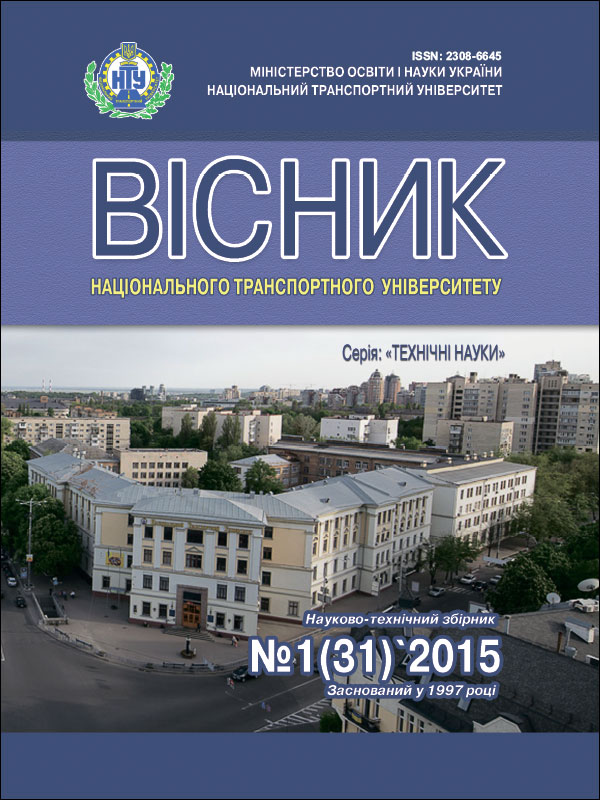DETERMINATION OF THE KINEMATIC VISCOSITY AND DENSITY OF THE MIXTURE OF DIESEL WITH ETHANOL AND DODECANOL
ABSTRACT
Krzemiński A. Determination of the kinematic viscosity and density of a mixture of diesel fuel with ethanol and the addition of dodecanol. Visnyk of National Transport University. Series «Technical sciences». Scientific and Technical Collection. – Kyiv: National Transport University, 2021. – Issue 3 (50).
The most popular group of alternative fuels is that derived from renewable sources. This group of fuels includes: vegetable oils and their derivatives (for example, esters of higher carboxylic acids) alcohols (for example, ethanol and methanol) ethers (for example, methyl tert-butyl ether, ethyl tert-butyl ether) liquid biomass processing products ( synthetic fuel). Among this group, the most interesting are alcohols, especially ethanol. This is due to the fact that ethanol has better physicochemical properties than methanol. It can be produced from renewable sources and the manufacturing process is not complicated. Drinking alcohol also reduces emissions of carbon dioxide (CO2) and toxic compounds such as particulate matter and nitrogen oxides (NOx) from diesel engines.
By using alternative fuels, costly engine design changes can be avoided and only regulatory changes can be made.
The miscibility of ethanol with diesel is influenced by water content and temperature. At a temperature of about 10 ° C, the mixture stratifies. One additive that can be used as a stabilizer for an ethanol-diesel mixture is dodecanol (C12H26). It is obtained by reduction of methyl esters. Dodecanol is solid at a temperature of 24 ° C, insoluble in water and mixes well with diesel fuel and ethyl alcohol.
In order for this type of fuel to be used to power diesel engines, it is necessary to know their physicochemical properties, since they have a significant impact on the correct operation of the internal combustion engine, operational parameters and the purity of exhaust gases into the environment.
The addition of ethanol to diesel fuel affects key properties such as kinematic viscosity and density. Viscosity affects the atomization and atomization characteristics of the combustion chamber. According to Soter, a lower viscosity value leads to smaller droplet diameters, thus increasing the surface area of the droplets significantly affects the evaporation time of the droplets. Taking into account the processes occurring in the injection systems, the choice of fuel with the optimal viscosity should be a compromise option. On the one hand, the increase in viscosity is favorable due to the efficiency and pressure in the high-pressure pumps and the lubrication conditions of the moving interacting elements of the injection system, but on the other hand, it leads to an increase in energy for pumping fuel into the supply system. On the other hand, an increase in density leads to an increase in particulate emissions. Low density is associated with lower heating value. This will affect the degradation of power and torque. In such a case, in order to reduce the difference, the fuel dose should be increased, the fuel consumption will be increased and the beneficial effect of low fuel density on the reduction of particulate matter emissions will be eliminated.
The article presents the results of the study of the issue substantiated the need to measure the kinematic viscosity and density of mixtures of diesel fuel with ethanol and dodecanol. The results of the viscosity measurements can be used to determine the injection parameters and the macrostructure of the atomized fuel flow.
KEY WORDS: DIESEL FUEL, ALTERNATIVE FUEL, ETHYL ALCOHOL, DODECANOL, KINETIC VISCOSITY.
REFERENCES
- Baczewski K., Kałdoński T. (2004): Paliwa do silników o zapłonie samoczynnym WKŁ, Warszawa 2004.
- Brzeżański M. (2007): Emisja dwutlenku węgla w aspekcie stosowanych paliw silnikowych. Combustion Engines PTNSS – 2007-SS4-225.
- Chłopek Z. (2010): Paliwa alternatywne do silników spalinowych a emisja dwutlenku węgla, Wydawnictwo ITS, Transport Samochodowy 2010, z.2.
- Di Y., Cheung C.S, Huang Z., Di Y. (2009): Experimental study on particulate emission of a diesel engine fuled with blended ethanol-dodecanol-diesel, Aerosol Science 40/2009.
- Górska M., Czerwonka D., Hernik A. (2017):, Ocena wybranych właściwości fizykochemicznych mikroemulsji paliwowych zawierających olej rycynowy, Autobusy 12/2017, 131-134.
- Hansen A.C., Zhang Q,. Lyne P. W. L. (2005): Ethanol - diesel fuel blends - a review, Bioresource Technology 96/2005, 277-285.
- Kuszewski H., Krzemiński A., Ustrzycki A. (2018): Wpływ zawodnienia alkoholu na pochodną liczbę cetanową mieszaniny oleju napędowego z etanolem oraz dodatkiem dodekanolu. Monografia pod redakcją naukową K. Lejdy, Seria: Transport, Nr, 9, Rzeszów 2018.
- Lejda K. (2004): Selected problems of fuel supply in high – speed Diesel engines, Published be Meta Lvov 2004 (pp.225).
- Lotko W. (1997): Zasilanie silników wysokoprężnych paliwami węglowodorowymi i roślinnymi. Wydawnictwo Naukowo – Techniczne, Warszawa 1997.
- Dokumentacja techniczna wiskozymetru HVU 482. Inkom Instruments Co., Warszawa 2011.
- Karta charakterystyki (2016): Alkohol etylowy całkowicie skażony. Alpinus 2016.
- Karta charakterystyki (2016): 1–Dodekanol ≥98% do syntezy. Carl Roth GmbH + Co KG. Karlsruhe 2016.
- https://hmdb.ca/metabolites/HMDB0011626
AUTHOR
KRZEMIŃSKI Artur, Rzeszów University of Technology, Department of Automotive Vehicles and Transport Engineering, e-mail: artkrzem@prz.edu.pl, tel.: +48 17 865 2550, 35-959, Rzeszow, Poland, Av. Powstancow Warszawy 12, orcid.org/0000-0003-4733-7308.
REVIEWERS
Balawender Krzysztof, PhD in Technical Sciences, associate professor, Rzeszow University of Technology, associate professor of the motor vehicles and transport engineering department, Rzeszow, Poland.
Gutarevych Yu.F., Doctor of Technical Science, professor, National Transport University, Head of the Engines and Heating Engineering Department, Kyiv, Ukraine.
Article language: Polish
Open Access: http://publications.ntu.edu.ua/visnyk/50/144-152.pdf
Print date: 29.09.2021
Online publication date: 30.10.2021
